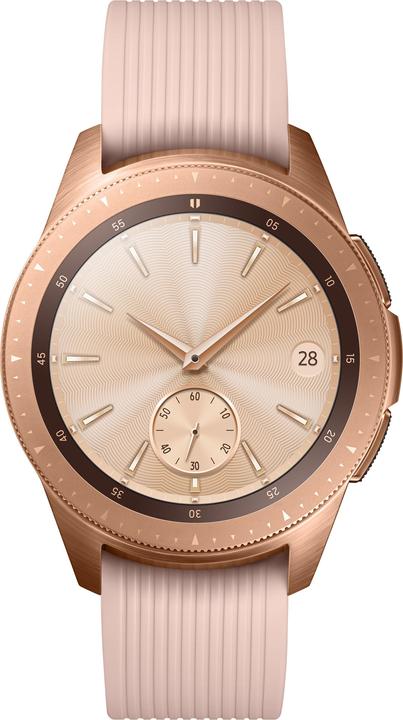
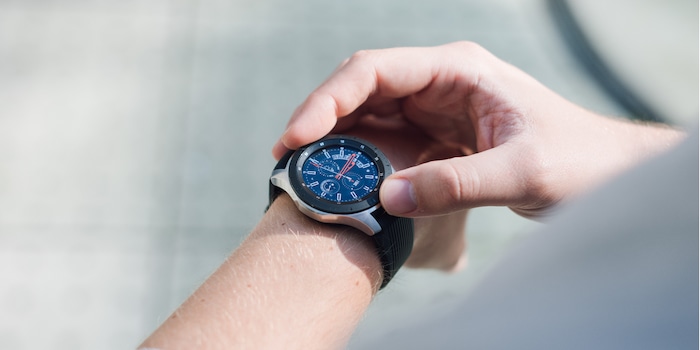
Samsung Galaxy Watch: The most beautiful block of all
The Samsung Galaxy Watch can do everything pretty well and nothing really badly. Find out what it has to offer and whether an upgrade is worthwhile for owners of its predecessor, the Gear S3, here.
August 2018: Samsung presents the successor to the Gear S3 Frontier in New York. Gear S so-and-so has been the usual name for Samsung smartwatches to date. The successor model, which goes by the name "Galaxy Watch", puts an end to this. The smart watch not only has a new name, but also a new processor that is supposed to be particularly energy-efficient.
And it looks damn good.
Style check: so what passed
Today, just over a month after the product launch, I'm looking at the 63 gram model with a case diameter of 46 mm. No problem for me thanks to my wide wrist, but the block is not for delicate wrists.
However, the Galaxy Watch looks very classy and is visually almost indistinguishable from an analogue watch. The display imitates a watch face that actually appears to be 2-3 millimetres below the Gorilla Glass. And if you miss the usual tick-tock sound of an analogue watch, you can switch it on if you wish: A gentle ticking sound can then be heard via the built-in speakers - great!
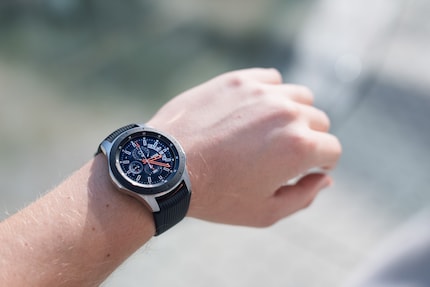
The smartwatch has a 1.3-inch AMOLED display with a resolution of 360 × 360 pixels. This makes it the same size as its predecessor Gear S3 Frontier and slightly smaller than the Apple Watch Series 4. The two smaller models, on the other hand, have a 1.2-inch display.
In terms of brightness, I have nothing to criticise: A sensor automatically adjusts the brightness to the ambient light, which means the display always remains easy to read - even in direct sunlight.
On the other hand, I'm a little disappointed with the sports wristband. Because Samsung also wants the Galaxy Watch to be a bit of a sports watch, the stainless steel case only comes with a silicone strap. I would have preferred something more elegant. An alternative is offered by straps from Strap Studio, which are also available from us.

But that's criticism on a high design level. My editorial colleagues have been complimenting me on the new, stylish watch for days (unfortunately, I'm not allowed to keep it). And I keep catching myself staring at my wrist with satisfaction. I don't really know myself to be that vain.
The home and back buttons on the right-hand side of the case and the bezel on the glass are also very useful. This allows me to navigate easily between apps and scroll within a page. Ease of use: top.
Software, battery and computing power
The operating system was a talking point in the run-up to the launch. The name "Galaxy Watch" was leaked days before the actual presentation. Until now, Samsung has only labelled smartphones under the name "Galaxy". Observers therefore assumed that the Galaxy Watch would run the Android-based Wear OS.
However, this is not the case, as Samsung has remained true to Tizen OS 4.0. The software is compatible with smartphones running Android 5 or higher as well as Apple's iOS. The smart watch is paired with the mobile via Bluetooth. We will also be offering a 4G version. When? At the moment it's early November. We will let you know.
The Galaxy Watch is powered by 768 MB of RAM and the new Exynos 9110 processor. The dual-core processor is clocked at 1.15 Ghz each. Samsung itself says that the new processor is significantly more energy-efficient than the Exynos 7270 installed in the previous models, which has a positive effect on battery life.

A statement that I agree with. I actually only charged the smartwatch about every four to five days, despite intensive use. The battery life only dropped dramatically when I activated the permanent location sharing function - i.e. GPS. The fact that the battery keeps up so well is also due to its capacity of 472 mAh - 100 mAh more than its predecessor. The two smaller Galaxy Watch models have to make do with a significantly smaller, 270 mAh battery.
A powerful processor and a long-lasting battery - during my two-week test phase, the smartwatch never felt slow or jerky. Swipes from one app to the next look smooth, all apps open quickly and respond promptly to input. Crashes or frozen still images? Not a thing.
A little tip: You can fill the 4 GB internal memory with music from your smartphone via the Galaxy Wear app. If you then connect the smartwatch to wireless headphones via Bluetooth, it becomes a replacement MP3 player. So you can go jogging, exercise or be otherwise active without your smartphone and listen to music at the same time.
Many useful apps for an active life
Because smartwatches are increasingly also sports watches, the Galaxy Watch has been given a variety of apps and functions, mainly centred around the Samsung Health app.
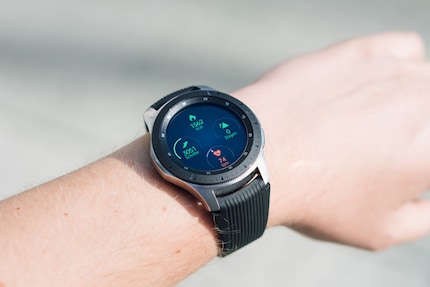
So it spits out a kind of "daily briefing" that always appears on the display when the smartwatch is strapped to the wrist in the morning. The briefing shows useful information such as the date, weather and upcoming appointments or reminders. In the evening, when the watch is taken off again, a summary of the day is displayed, showing whether activity targets - such as steps walked or number of active minutes - have been achieved. And a weather forecast for the next day is also included. Not bad.
Of course, I can also use the Health app to record sleep phases, measure my heart rate and count the number of steps or calories I've walked each day. A total of 40 sports activities such as jogging, swimming, cycling or strength training can also be tracked - the Samsung Gear Sport had 17 activities.
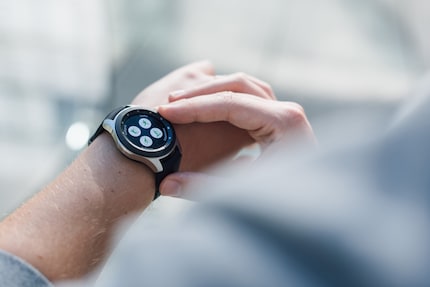
Speaking of swimming: The smartwatch is IP68 certified and can be taken into the water with confidence. A useful water lock function prevents the watch from accidentally interpreting splashes of water as gestures or touches. Marketing Manager Andrea Jacob took one with her on her weekly swim training session and deliberately compared apples with pears: In about three weeks, you'll be able to read a comparison test between the Galaxy Watch and Garmin fenix 5S Plus.
There are downsides to all this tracking. I keep noticing that without a watch on my wrist, steps feel wasted because they are not recorded. The watch uses biomarkers - of which I have no idea what they are - to measure the current stress level. Every time I've seemed stressed on my watch, it has prompted me to do things like breathing exercises. Even while writing this article, I have been urged several times to be more active and do torso twists. But I am the calm personified, hmpf!
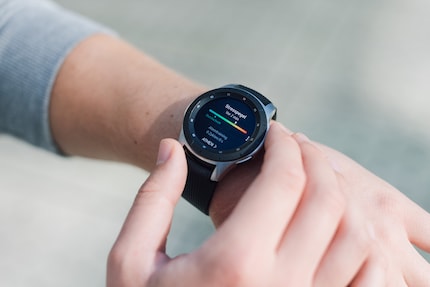
Agree, it's all well meant. And my waistline tells me that I should be a little more receptive to tips like this. But the constant beeping, vibrating and urging to be more active is annoying. Fortunately, most of the functions - such as this stress measurement mumbo-jumbo - can be deactivated.
Integrated speaker and microphone
The smartwatch has an integrated speaker and microphone on the left of the casing. This allows me to answer calls directly on the Galaxy Watch and speak into the watch à la David Hasselhoff in "Knight Rider". This has proved useful when driving, for example, because I don't have a hands-free system. It goes without saying that I kept both hands on the steering wheel when driving.
The speaker quality will certainly not win any awards, but nobody expects that from speakers that are integrated into a watch case. The speaker function should be particularly useful for the 4G version, which works with an eSIM, because it means you can leave your mobile at home when you're training outdoors.
Small side note: Yes, thanks to the microphone and Bixby, the smartwatch can also be voice-controlled. And yes, Bixby is still just as useless as the world's longest instruction leaflet because it only understands English and doesn't know what to do with Switzerland.
Conclusion: Almost unreserved recommendation to buy
If someone were to ask me whether I would recommend the smartwatch, my answer would be: Yes, definitely, with a small "but".
The "but" concerns owners of the predecessor model Gear S3 Frontier who are considering an upgrade. Because the Galaxy Watch doesn't really offer much that's new. Both models look practically identical and have the same size and resolution. Both are IP68-certified, MIL-STD-810G and protected against water and dust up to 5 ATM. The ribbing of the bezel, on the other hand, is similarly fine as on the Gear S3 Classic, and there are four green LEDs underneath the case that light up on the skin to measure the pulse.
Samsung seems to have focussed more on existing strengths. For example, the battery, which lasts four to five days depending on use, is a stunner. The computing power under the bonnet has been improved and allows the bug-free software to run smoothly.
So the Galaxy Watch is a smartwatch for all those who don't yet own one but don't want to settle for (too) cheap, wishy-washy entry-level watches. With its stainless steel design, it looks damn smart and has an excellent finish. The Tizen software offers plenty of useful functions out of the box, and the Health app keeps you on your toes. And yes, the AMOLED display, which deceptively imitates a real watch face, is a real eye-catcher.
Well, now I just have to make sure that I somehow get to keep this trial model.
I write about technology as if it were cinema, and about films as if they were real life. Between bits and blockbusters, I’m after stories that move people, not just generate clicks. And yes – sometimes I listen to film scores louder than I probably should.

